冀教英语九年级上教案Unit 2 第4课时
新冀教版英语九年级上册《unit 2 biggestlongestwidest》优秀教案(重点资料).doc
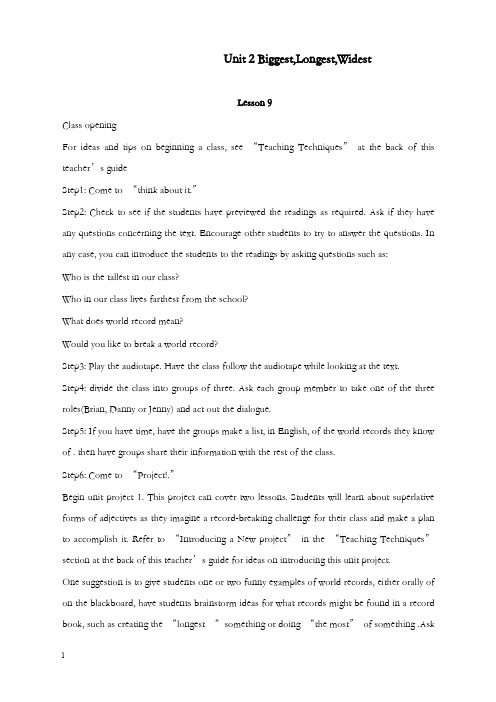
Unit 2 Biggest,Longest,WidestLesson 9Class openingFor ideas and tips on beginning a class, see “Teaching Techniques”at the back of this teacher’s guideStep1: Come to “think about it.”Step2: Check to see if the students have previewed the readings as required. Ask if they have any questions concerning the text. Encourage other students to try to answer the questions. In any case, you can introduce the students to the readings by asking questions such as:Who is the tallest in our class?Who in our class lives farthest f rom the school?What does world record mean?Would you like to break a world record?Step3: Play the audiotape. Have the class follow the audiotape while looking at the text.Step4: divide the class into groups of three. Ask each group member to take one of the three roles(Brian, Danny or Jenny) and act out the dialogue.Step5: If you have time, have the groups make a list, in English, of the world records they know of . then have groups share their information with the rest of the class.Step6: Come to “Project!.”Begin unit project 1. This project can cover two lessons. Students will learn about superlative forms of adjectives as they imagine a record-breaking challenge for their class and make a plan to accomplish it. Refer to “Introducing a New project”in the “Teaching Techniques”section at the back of this teacher’s guide for ideas on introducing this unit project.One suggestion is to give students one or two funny examples of world records, either orally of on the blackboard, have students brainstorm ideas for what records might be found in a record book, such as creating the “longest “something or doing “the most”of something .Aska volunteer to record their suggestions on the blackboard. Help the students choose the appropriate form of superlative (either adding the suffix’est or using most.”)Divide the class into small groups. Have each group discuss and decide what world record the class should try to break. They can use one of the suggestions in the class list or invent a new one. Ideas can be either funny or serious, but they should be possible (if they had time ., opportunity and the cooperation of all of the students!) have the groups begin planning for breaking this world record.Conclude unit project 1. students continue to work in the same groups. They complete their plan for breaking a record. Groups report their plan for breaking a record. Groups report their plans to the class or exchange plans with another group.Class closingThe first reading in the reader.The remaining exercises in the activity book.The next reading in the student book.Lesson 10Class openingFor ideas and tips on beginning a class , see “Teaching Techniques”at the back of this teacher’s guide.Step1: Come to “think about it.”Step2: Check to see if the students have preview ed the reading as required. Are there any questions? Select one or two sentences containing key words or phrases and ask if anyone has figured out the meaning. If a student replies correctly, ask him or her to share the strategies used to puzzle out the meanings. Remember to give lots of praise for a good try, even if it’s wrong.You may find it necessary to briefly menti on the following words, in order to he lp smooth the way for teaching the reading. You may wish to write this list on a large sheet of paper in advance of this lesson.Grand HyattJin Mao TowerStructureThe Great WallDamThe Three Gorges DamNow introduce the reading to the class by asking the following questi ns:What is the tallest building in the world?[来]What is the biggest dam in the world?What is the longest wall in the world?Students should be encouraged to refer to the reading to the answers.Step3: Play the audiotape . Have the class follow though audiotape while reading the text. Step4: Divide the class into small groups. Have each group do one of two things: make a list of the world records with the details mentioned in the reading : or make a list of world records for China that the students know of .(Hints: population: sports, particularly ping-pong, women’s volleyball and gymnastics: bicycles,Step5: If time allows, have one or two groups share their lists with the rest of the class.Step6: Come to “let’s do it.”Class closingThe second reading in the readerThe remaining exercises in the activity bookThe next reading in the student bookLesson 11Class openingFor ideas and tips on beginning a class, see “Teaching Techniques”at the back of this teacher’s guide.Step1: Check to see if the students have previewed the reading as required. You may wish to mention the comparative and superlative forms of words that appear in the reading. Select a few of these words and ask if anyone has figured out the meaning. If a student relies correctly, ask him or her to share the strategies used to puzzle out the meaning. Remember to give lots of praise for a good try, even if it’s wrong.Step2: Ask the class to read the dialogues and ask, “What’s does ‘stand on one foot’mean?”Step3: Introduce the class to the reading “Special Animals”by asking the following questions. Encourage the students to refer to the reading for the answersWhat is the largest animal in the world?What is the smallest animal in the world?What is the oldest animal in the world?What is the fastest animal in the world?Step4: Play the audiotape. Have the class follow the audiotape while reading the text.Step5: Divide the class into small groups. Ask each group to discuss the reading and then make a list of the world records for animals with the details provided in the text.Step6: If time allows, have the students discuss what else they know about animal world records.Step7: Come to “Let’s do it.”Class closingThe third reading in the readerThe remaining exercises in the activity bookThe next reading in the student bookLesson12Class openingFor ideas and tips on beginning a class, see “Teaching Techniques”at the back of this teacher’s guide.Step1: Check if the students if they have previewed the song aas required. Ask the class to look for adverbs and adjectives that occur in the reading, such as far, long, high, fast, strong, and thick. As students call out words, ,make a list on the the blackboard. Ask students to give the comparative and superlative forms of the above words, IN the case of far, for example, the forms are farther and farthest.Step2: Divide the class into two groups. Ask each group to read one line of the song at a time as a poem. One group could read the lines aloud while the other group performs the song with actions. This will tell you how well the students have understood the song and how well they have learned to appreciate it.Step3: Play the audiotape. Have the class follow the audiotape and sing along.Step4: Practice until everybody in the activity bookStep5: Come to “Let’s do it.”Class closingThe remaining exercises in the activity bookThe next reading in the student bookIf you have time, end the class by singing the song “Let’s Go the Farthest!”Lesson 13Class openingFor ideas and tips on beginning a class, see “Teaching techniques”at the back of this teacher’s guide.Step1: Come to “think about it”.Step 2: Check to see if the students have previewed the reading as required. Ask if they have any questions concerning the text. Encourage other students to try to answer the questions. Again, you may want to mention the superlative forms of the adjectives that appear in the reading (youngest, oldest, fastest, highest, farthest, most, greenest, fewest, longest). Can students identify these words? Do they understand the meanings?Step3: Play the audiotape. Have the class follow the audiotape while looking at the text.Step4: Divide the class into small groups. Ask each group to discuss the reading. Have each group make a list of the suggestions for class records made in the reading.Step5 :If time allows, ask each group to make further suggestions for class records. They should try to use categories that apply to their classmates. Try to make it fun!Step6: Come to “Project2.”Begin unit project 2, which can cover four lessons.Write on the blackboard “the most .”Have students list examples of words that would fit in the blank. Ask them to compare their suggestions. By questioning , elicit from them the information that “most”can be used with a noun to refer to either number or volume. “Most”can also be used with modifiers to form the superlative. (They don’t have to use these grammatical terms!) Ask students to give examples of records that could be found in this category; for example, “the most children in a family, “remind students that the most common form of making the superlative is to add the suffix “est”to the end of an adjective. As a class, brainstorm categories for possible records that could be set for your class, have a volunteer write the suggestions of categories on the board for the students to copy. Continue unit project2. As a class, agree on a final list of categories, Prompt the students to use the vocabulary for this lesson as well as other English words they know.Have students work with a partner or in a small group. Each team should choose a category for possible records in their class. They will use the objects and people in their classroom for research data. Each team will plan their research and divide the tasks between the team members. For example, one or more students would make measurements or ask questions to get information and another student would record the data on a chart.Conclude unit project 2. Ask two volunteers to facilitate recording the information on a large poster of on the blackboard, listing all of the records for the class. One volunteer can ask each team for their record while the other writes down the information. Teams must give their information in a complete sentence using appropriate vocabulary. For example, “Li Ping is the tallest student.”Class closingThe fourth reading in the readerThe remaining exercises in the activity bookThe next reading in the student book每个同学总结自己所知道的班里的一些最高记录保持者,并且make a list, 课上读给大家,课下做成墙报贴到教师的墙上。
冀教版九年级英语全册Lesson4Don’tSmoke,Please!教学设计

冀教版初中九上Unit 4 Stay HealthyLesson 4 Don’t Smoke, Please!同步教案Navigation of the course(课程导航)Teaching aims(教学目标)1. 让学生懂得吸烟有害健康,被动吸烟甚至更严重2. 让学生找出一些禁止吸烟的地方3. 谈谈吸烟容易引起那些疾病Teaching important points(教学重点)1. New words and new phrases of the text.2. Enable to talk about the harm of smoking.Teaching difficult points(教学难点)Enable to talk about the harm of smoking.Guiding teaching scene(教学情景导入)Hello, everyone. Look at the sign. What’s the meaning of it?Right. No smoking, please. Smoking is a bad habit. It is bad for the person who smokes and his families. It can cause firing. Is there someone smoking at home? If yes, what should you do now? Great. Ask him/her to give up smoking for the family. Don’t smoke, please.教学过程设计Step1. Warming up: Discuss the following questions with your students.?List of the serious diseases in the world today.?Why do people get ill??What should we do to stay healthy?Step2. Learning new words of the text.smoke v. 吸烟harmful adj. 有害的public adj. 公共的law n. 法律whenever conj无论何时risk n. 危险somebody pron. 有人disease n. 疾病lung n. 肺breathe v. 呼吸cigarette n. 香烟Step3. Read and finish Exercise 1 on Page 9.Ask students to talk about in groups. Then check answers as a class.Step 4. Explain the text and learn the language notes1. Smoking is also bad for your heart. 抽烟对你的心脏有害。
【冀教版】九年级英语 Unit2 教案

Unit 2 Great PeopleLesson 7: What Is the Meaning of Life?I. Learning aims:Master the new words:meaning, dialogue, successful, survey, neighbourII. Learning important and difficult points:1) Those are all really important questions and very difficult to answer.2) I’m not sure how to answer them.3) My dad always says that we should be good to others.4) Let’s write these questions down.Language Points:1. meaning【用法】作可数名词,意为“意思”,是动词mean的动名词形式起形容词作用。
【举例】Can you tell me the meaning of this new word? 你能告诉我这个生词的意思吗?2. Those are all really important questions and very difficult to answer. 那些都是很重要的问题并且很难回答。
【用法】句式“be + 形容词+ 不定式”意为“很……做某事……”。
【举例】This kind of work is easy to complete. 这种工作很容易完成。
3. I’m not sure how to answer them. 我不能肯定如何回答它们。
【用法】不定式可以与疑问词 who, what, which, when, how, where 等连用,构成不定式短语,在句中作主语、表语、宾语和宾语补足语等。
Unit2九年级英语冀教版教案

Unit2九年级英语冀教版教案Unit 2: Ninth Grade English Teaching PlanObjective:At the end of this unit, students will be able to understand and use adjectives to describe people, places, and things in English.Lesson 1: Describing PeopleIntroduction:In this lesson, students will learn how to use adjectives to describe people's physical appearance and personality traits.Warm-up activity:- Have students work in pairs or small groups and describe the physical appearance of their favorite celebrity or fictional character.- Encourage them to use a variety of adjectives and provide examples.Presentation:1. Introduce the key vocabulary words for describing physical appearance, such as tall, short, thin, overweight, etc.2. Show pictures of different people and ask students to describe their physical appearance using the new vocabulary.3. Discuss the importance of using appropriate adjectives to describe people accurately.Practice:1. Divide students into pairs and give each pair a set of picture cards depicting various people.2. Have them take turns describing the physical appearance of the people in the pictures to their partner.3. Encourage the use of adjectives and provide guidance as needed.Extension activity:- Have students write a short paragraph describing the physical appearance of a family member or a friend.Lesson 2: Describing PlacesIntroduction:In this lesson, students will learn how to use adjectives to describe different types of places.Warm-up activity:- Display pictures of different places, such as a beach, a city, a forest, etc.- Ask students to brainstorm adjectives to describe each place.Presentation:1. Introduce the key vocabulary words for describing places, such as crowded, peaceful, scenic, etc.2. Show pictures of different places and ask students to describe them using the new vocabulary.3. Discuss how different adjectives can create different impressions of a place.Practice:1. Divide students into small groups and give each group a different picture of a place.2. Have them take turns describing the place to their group members using appropriate adjectives.3. Encourage discussions and comparisons between different places.Extension activity:- Have students write a short paragraph describing their favorite place using descriptive adjectives.Lesson 3: Describing ThingsIntroduction:In this lesson, students will learn how to use adjectives to describe objects and things.Warm-up activity:- Bring in various objects, such as a book, a pencil, a toy, etc.- Ask students to describe the objects using adjectives.Presentation:1. Introduce the key vocabulary words for describing things, such as big, small, colorful, etc.2. Show different objects and ask students to describe their characteristics using the new vocabulary.3. Discuss the importance of using specific adjectives to describe objects accurately.Practice:1. Give each student a small object and ask them to describe it to a partner using appropriate adjectives.2. Encourage students to be creative and use a variety of adjectives.3. Have pairs switch objects and repeat the activity.Extension activity:- Have students bring in an object from home and write a short paragraph describing it using descriptive adjectives.Conclusion:By the end of this unit, students will have developed the ability to describe people, places, and things using adjectives accurately. This will enhance their English language skills and allow them to communicate more effectively.。
冀教版英语九年级全一册 Unit 2 教案
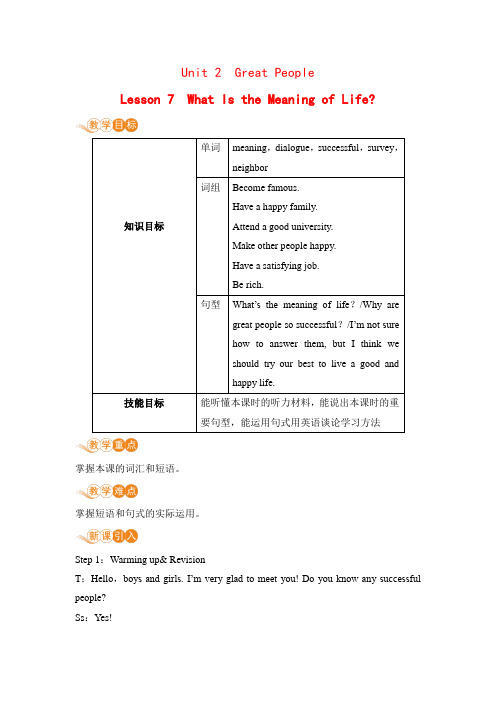
Unit 2 Great PeopleLesson 7 What Is the Meaning of Life?知识目标单词meaning,dialogue,successful,survey,neighbor词组Become famous.Have a happy family.Attend a good university.Make other people happy.Have a satisfying job.Be rich.句型What’s the meaning of life?/Why are great people so successful?/I’m not surehow to answer them, but I think weshould try our best to live a good andhappy life.技能目标能听懂本课时的听力材料,能说出本课时的重要句型,能运用句式用英语谈论学习方法掌握本课的词汇和短语。
掌握短语和句式的实际运用。
Step 1:Warming up& RevisionT:Hello,boys and girls. I’m very glad to meet you! Do you know any successful people?Ss:Yes!T:OK!Please answer my questions. What is success?How do you know if you have succeeded? Please tell me,OK?Ss:Yes!(几个学生起立自由回答,教师把学生的答案写在黑板上)设计意图:此环节通过师生互动导入本单元话题,渲染课堂气氛,激发学生的学习兴趣,消除学生一节课开始的紧张感,为接下来的讨论做准备。
Step 2:Pre-reading1.Teach phrases and practice the sentence patterns教师出示本课单词的图片,导入词汇、短语、句型的学习。
精编冀教版九年级英语上册一二单元教案(1-12课).docx

冀教版九年级英语上册一二单元教案(1-12课)Unit 1 Stay Healthy(1-6 课)Lesson 1: What' s Wrong, Danny?I.Learning aims:Master the new words:stomach, regret, fev.er, pale, Sara, exam in ation, pain, X-rayII.Learning important and difficult points:1)Danny wakes up his parents・2)I regret eating so many donuts now・3)Need we go there right now?4)She takes them to a small examination room・5)Danny needs to stay in the hospital today.Language Points:1.regret【用法】作及物动词,意为“对……感到后悔”,后加名词、代词、动名词作宾语。
【举例】①Tony has been regretting that matter.托尼对那件事情一直感到很后悔。
②I regret making such a foolish decision.我后悔做出这么愚蠢的决定。
【用法】作不可数名词,意为“遗憾、惋惜”。
【举例】His great regret is not seeing his father for the last time・他最大的遗憾是没有能最后一次见他父亲一面。
2.Danny wakes up his parents・丹尼把他的父母叫醒了。
【用法】短语wake up意为“叫醒”,这是“动词+副词”短语。
这类短语用名词作宾语时,名词可在副词前,也可用在副词后;如用代词作宾语时,代词则必须用在副词前。
故这句话中的wake up his parents还可说为wake his parents up。
【教育资料】冀教版九年级英语全册Lesson 2 A Visit to the Dentist教案学习精品
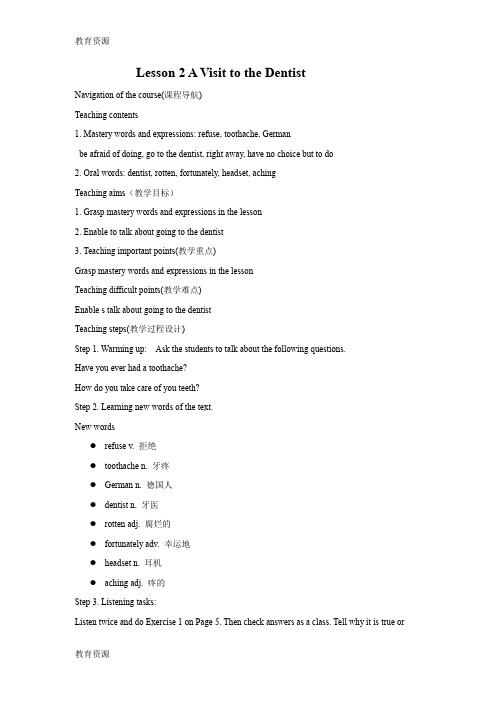
Lesson 2 A Visit to the DentistNavigation of the course(课程导航)Teaching contents1. Mastery words and expressions: refuse, toothache, Germanbe afraid of doing, go to the dentist, right away, have no choice but to do2. Oral words: dentist, rotten, fortunately, headset, achingTeaching aims(教学目标)1. Grasp mastery words and expressions in the lesson2. Enable to talk about going to the dentist3. Teaching important points(教学重点)Grasp mastery words and expressions in the lessonTeaching difficult points(教学难点)Enable s talk about going to the dentistTeaching steps(教学过程设计)Step 1. Warming up: Ask the students to talk about the following questions.Have you ever had a toothache?How do you take care of you teeth?Step 2. Learning new words of the text.New words●refuse v. 拒绝●toothache n. 牙疼●German n. 德国人●dentist n. 牙医●rotten adj. 腐烂的●fortunately adv. 幸运地●headset n. 耳机●aching adj. 疼的Step 3. Listening tasks:Listen twice and do Exercise 1 on Page 5. Then check answers as a class. Tell why it is true orfalse.Step 4. Reading tasks:Read in groups and finish Exercise 2 on Page 5. First discuss in groups, then ask each group to give their answers. Encourage them to use their own words to tell the main idea of each paragraph.Step 5. Explain the language notes to the students.1. I’m really afraid of going to the dentist. 我真的害怕去看牙医。
英语Unit 2 Biggest,Longest,Widest Lesson 4英文教案(冀教版九年级上)
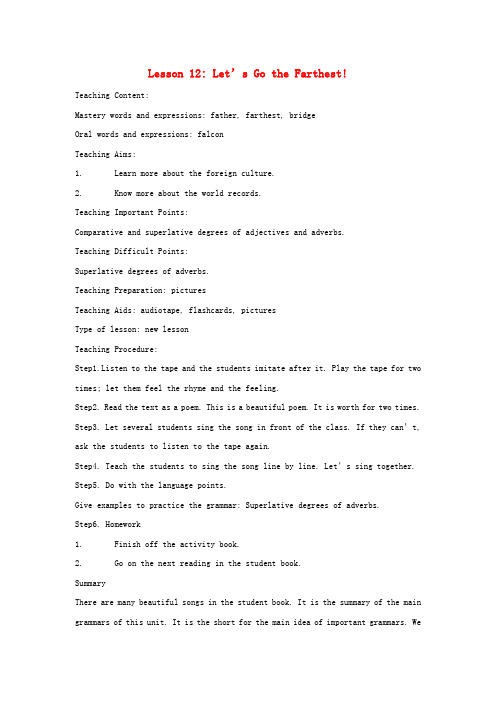
Lesson 12: Let’s Go the Farthest!Teaching Content:Mastery words and expressions: father, farthest, bridgeOral words and expressions: falconTeaching Aims:1. Learn more about the foreign culture.2. Know more about the world records.Teaching Important Points:Comparative and superlative degrees of adjectives and adverbs.Teaching Difficult Points:Superlative degrees of adverbs.Teaching Preparation: picturesTeaching Aids: audiotape, flashcards, picturesType of lesson: new lessonTeaching Procedure:Step1.Listen to the tape and the students imitate after it. Play the tape for two times; let them feel the rhyme and the feeling.Step2. Read the text as a poem. This is a beautiful poem. It is worth for two times. Step3. Let several students s ing the song in front of the class. If they can’t, ask the students to listen to the tape again.Step4. Teach the students to sing the song line by line. Let’s sing together. Step5. Do with the language points.Give examples to practice the grammar: Superlative degrees of adverbs.Step6. Homework1. Finish off the activity book.2. Go on the next reading in the student book.SummaryThere are many beautiful songs in the student book. It is the summary of the main grammars of this unit. It is the short for the main idea of important grammars. Wemust learn the song by our hearts. It is very useful for the students to learn more about the foreign culture.。
最新九年级英语冀教版上册 Unit2 教学设计
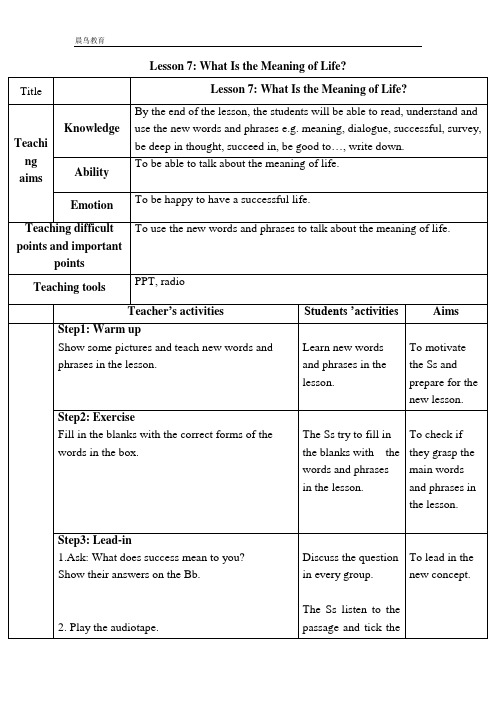
To get to know the key information about the lesson.
To get to know thedetails about the lesson.
Step 4: Exercise
*meaning go to college
*survey have a good job
Lesson 8: A Universe of Thought
Title
Lesson 8: A Universe of Thought
Teaching aims
Knowledge
By the end of the lesson, the students will be able to read, understand and use the new words and phrases e.g. solve, pioneer, go on to…, in the field of…, pass away.
Board Design
Lesson8 A Universe of Thought
To give Ss time to prac-
tice their speaking abilities.
Step6: Writing
Ask the Ss to write a short passage abouttheirsurvey.
Write a short passage abouttheirsurvey.
Discuss the question in every group.
The Ss listen to the passage and tick thesentences mentioned.
冀教版九年级英语上册unit4教案(冀教版英语九年级)
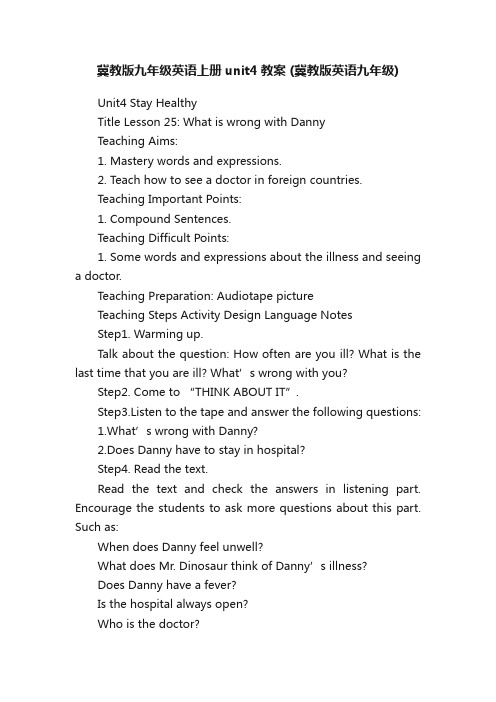
冀教版九年级英语上册unit4教案 (冀教版英语九年级)Unit4 Stay HealthyTitle Lesson 25: What is wrong with DannyTeaching Aims:1. Mastery words and expressions.2. Teach how to see a doctor in foreign countries.Teaching Important Points:1. Compound Sentences.Teaching Difficult Points:1. Some words and expressions about the illness and seeinga doctor.Teaching Preparation: Audiotape pictureTeaching Steps Activity Design Language NotesStep1. Warming up.Talk about the question: How often are you ill? What is the last time that you are ill? What’s wrong with you?Step2. Come to “THINK ABOUT IT”.Step3.Listen to the tape and answer the following questions:1.What’s wrong with Danny?2.Does Danny have to stay in hospital?Step4. Read the text.Read the text and check the answers in listening part. Encourage the students to ask more questions about this part. Such as:When does Danny feel unwell?What does Mr. Dinosaur think of Danny’s illness?Does Danny have a fever?Is the hospital always open?Who is the doctor?What does the doctor say to Danny?Check the answers and give them enough hints to answer the questions.Step5. Act out:Act out the dialogue in front of the class. Make another dialogue to perform in the class. The roles are doctors and patients and the patients’ family members.e to “LET’S DO IT.”Make up a dialogue in front of the class. When they are acting, help them when it is necessary. Teach them more new words about illness and parts of the bodyStep7. Homework1. Finish off the activity book.2.Go on the next reading in the student book. * Let the students talk about the questions in groups. Then give a report to the class. They can make up a dialogue in pairs or in three or four.If time is not enough, you can choose several groups to perform in front of the class.* This is a difficult task for the students. If the questions are a little difficult, they can’t answer them. But we don’t have time to let them listen again* Divide the class into several groups and act out the role-play in front of the class. Choose the best one and give them praise.* Teach them more new words about illness and parts of the bodyBlackboard Writing Design:After Class(教学反思):Title Lesson 26: Where Is Danny ?Teaching Aims:1.Learn more expressions for describing illness and treatment.2.Know how to see a doctor in foreign countriesTeaching Important Points:1.Know some knowledge about the illness and the treatment.2.Go to see a doctor.Teaching Difficult Points:1.Know some words and expressions about the illness and the treatmentTeaching Preparation:Teaching Steps Activity Design Language NotesStep1.Warming-upTalk in groups about the showings about the cold. The teacher asks the st udents “When you catch a cold, how do you feel?” Let the students sum the phenomenon of the cold. Then give a report in the class. They can begin like this: when I have a fever, I…Step2. Come to “THINK ABOUT IT”.Talk about the following question: “What d o your father and mother usually tell you to do when you catch a cold?”At the same time, ask the students to talk about the question: “What do your parents do when you are ill? How do they feel when you are ill?”Step3.Listening taskListen to the tape and answer the following questions:What’s wrong with Brian?What does Jenny do to help Brian?Finish the exercises in oral in class.Step4. Reading taskRead the text and fill in the blanks according to the text.1. _______ almost never gets sick.2.Brian’s ________ and _______ hurt.Jenny brought some _______ _______ for lunch.Jenny says to Brain: “_______ _______.”Finish the blanks in class in oral.e to “PROJECT”Divide the class into groups in three or four. Complete the dialogues. In the group, one is a patient. Another is a doctor. The others can be the nurses or the patients’ family members.Let the students grasp the words and expressions of illness and treatment. Encourage the students to read their student books and readers to find out facts about cases and symptoms of common illness.Step6. HomeworkFinish off the activity book.Go on the next reading in the student book.*S1: When I have a cold, I have a fever.S2: When I have a cold, I often cough day and night.S3: When I have a cold, I often have a running nose.S4: When I have a cold, I often have a headache.*S5: My father and mother usually tell me to drink more water and take medicine three times a day.When I’m ill, my mother looks after me at home. She can’t go to work.S6: My parents tell me to keep warm and drink more water. When I have to get an injection, my parents are sad.S7: My parents often tell me to play inside and take medicine. When I am ill, my parents are worried.*After they grasp more words and expressions about theillness, they can begin the role-play.Blackboard Writing Design:After Class(教学反思):Title Lesson 27: Good Food, Good HealthTeaching Aims:1.We must eat healthy and keep healthy.2.Know about the balanced diet.Teaching Important Points:1.Know more words about the names of the grain in our daily life.2.How to eat healthy and keep healthy.Teaching Difficult Points:What is a balanced diet?Teaching Preparation:Teaching Steps Activity Design Language NotesStep1.warming up:Talk about the question: what do you eat in your daily life? Do you think what the foods you eat contain?Step2.Read the text and answer the following questions:1.What do bread, noodles and rice come from?2.Is fruit different from vegetables?Answer the questions in class in oral. If they can’t answer them correctly, let them read the text. Help them find the correct answer.Step3. Read the text in details and finish the exercises.Read the text and fill in the blanks:1.Bread, noodles and rice are made from _______.2 ______and _______are very good source of ________, _______ and _______.3. ______ ______ are made from potatoes.4.Salad is made of _______ ________.5.Many people think that only meat and chicken have _______.______ makes your bones and teeth strong.Step4.Listen to the tape and let the students follow it for two time. Let them have the correct pronunciation and intonation.Step5. Ask some students to read the text in the class. Don’t read the whole text, read only the important words, expressions and sentences.Step6. Come to “LET’S DO IT”.Fill in the chart to compare the eating habits of your classmates.Interview four or more students to fill in the chart. They can design more questions to ask the others.Step7.HomeworkFinish off the activity book.Go on the next reading in the student book * Some words are too difficult for them to answer, so the teacher shows some new words to them with pictures.Blackboard Writing Design:After Class(教学反思):Title Lesson 29:Don’t Smoke, Please!Teaching Aims:1.Know more about disease.2.Learn the harm of smoking and drinking.Teaching Important Points:1.Some words and expressions about the disease.2.Know how to keep healthy.Teaching Difficult Points:Help people keep healthy.Teaching Preparation:Teaching Steps Activity Design Language NotesStep1.Warming up:Divide the class into groups of three or four. Talk about the following questions: what do you think of smoking?The teacher: Some boy students think smoking makes them look more handsome. Is it right? No, it’s very wrong. Smoking is more harmful to all the people around the world. Now let’s talk about the topic in groups. After a while, every group will give a talk in front of the class.Step2. Come to “THINK ABOUT IT”.When we are talking the two questions, we can use the Internet to help us. Search more information for the students. Search more pictures to show the students how many pains have the diseases brought us.Ask some students to answer the questions.S1: When I eat too cold food, my stomach always hurts..S2: When I have a fever, I know I have a cold.S3: I have a headache when I wear fewer clothes in winter.Step3. Listen to the tape and answer the following questions: What’s wrong with Danny?How is Brian today?Step4. Read the text and Fill in the blanks:Brian feels ______ on Monday.Brian wants to make a poster about ________.Smoking is also bad for your _______.Step5. Make sentences with the following language points: be away fromLi Ming has been away from school for ten days.ifIf the weather is fine, we will go the park tomorrow.alsoHe is also a doctor.Step6. Come to “PROJECT”.Divide the class into groups of three or four to finish the task. Discuss the diseases causes by smoking and drinking. It can be divided into two steps. The first step, talk the harm of smoking. Drinking is more harmful than smoking. Many people died from drinking every year. They drink too much, but they still drive their cars. Now too many accidents happen on the road.Make a poster to show the harm of smoking and drinking for people. Every group makes their posters and explains to the others what it means.Put the posters up in the class. Every group sends a poster to the teachers in the school. Let all the teachers tell the students about the harm of smoking and drinking.Step7. Homework:Finish off the activity book.Go on the next reading in the student book.* Group1: We all think smoking is a great harmful to the bodies. Many people die of lung cancer every year. Lung diseases sometimes causes by smoking.Group2: I also think smoking is bad for health. So give your friends or relatives advice. Let them give up smoking.Every group gives their report. Then the teacher sums their talks in class..* After playing the tape, the teacher checks the answers.Blackboard Writing Design:After Class(教学反思):Title Lesson 30: Jane’s Lucky LifeTeaching Aims:1.The spirit of the disabled.2.Know more about the disabled people.Teaching Important Points:Learn the spirit of the disabled people.Teaching Difficult Points:Know about the difficulties that the disabled people have to face in the world.Teaching Preparation:Teaching Steps Activity Design Language NotesStep1.Warming up:If you are a disabled person, what problems will you meet?Divide the class into groups of three or four. The teacher can design the task for every group.Step 2. Come to “THINK ABOUT IT”.Ask some students to talk about the questions in pairs. Then let some students demonstrate their opinions in class.Step3. Look at the picture of J ane. Do you think what’s wrong with Jane? Do you think she is happy? Why?Step4. Read the text and let’s learn more about Jane. Encourage the students to ask more questions about this part.S1: How old is Jane?S2: She is forty years old.S3: What is she unable to do?S4: She is unable to brush her teeth. She can’t run or jump. She can’t make breakfast.S5: Is she married?S6: Yes, she has a daughter and a son.If some students can’t answer some of the students, the teacher helps them.Step5. Demonstrate the dialogue in part 2.Let some students act out the dialogue in front of the class.Step6: Listen to the tape and read after it for several times. Play the tape for several times in order to let them have correct answers.Step7. Imagine you are Jane. What difficulties will you meet in your life?Step8. Come to “LET’S DO IT”.Divide the class in groups and discuss the questions. Let them demonstrate their opinions freely. The teacher should help them if they are in trouble. Remember them to think about the problem in right ways.Step9. HomeworkFinish off the activity book.Go on the next reading in the student book.* Group1 lost an arm in an accident. Now what difficulties will you meet?Group 2 lost a leg in an accident. Now what difficulties will you meet?Group 3 is deaf.Group4 is blind.Let the students talk about their problems for five minutes. Then give a report in the class.*Ask some students to answer the questions in class. Do you think when you are happy?*The teacher should help them if they are in trouble. Remember them to think about the problem in right ways.Blackboard Writing Design:After Class(教学反思):Title Lesson 31: Danny Tells AllTeaching Aims:1.Know more about the disease.2.Learn more about the hospital in foreign country.Teaching Important Points:1.Know something about the disease and hospital in foreign countries.2.How do we feel when we are in hospital?Teaching Difficult Points:Demonstrate the feeling in hospital.Teaching Preparation:Teaching Steps Activity Design Language NotesStep1.Warming up:What do you think of Danny? Do you miss him? What do you want to know about him?Step2. Listen to the tape and answer the following questions: What’s wrong with Danny?Where is Danny now?Let the students answer the questions in class in oral.Step3.Read the text and encourage students to ask more questions:S1: Who went to see Danny in hospital?S2: Brian and Jenny.S3: What did Danny feel about missing school?S4: He felt terrible.S5: Is everyone quiet as Brian reads the letter?S6: Yes.S7: What did the doctor take from Danny’s stomach?S8: An appendix.Give them hints and let them ask more questions.Step4. Make sentences with the following language points:1.I have something to tell you.They have a lot of homework to do.2.in hospital; in the hospitalI was ill in hospital last year.We went to see my uncle in the hospital.I’m feeling much better.Much equals a lot, even, far, a littlee to “LET’S DO IT”.Divide the class into groups. Talk about the questions. After a while, let some students give their report to the class.Step6. HomeworkFinish off the activity book.Go on next reading in the student book.* Let some students answer the questions in class in oral. Pay attention to the words that they are using. If you think it is necessary to show more words, you can show some new words to them.* Show them more words and expressions about disease with the cards.When the students are discussing, the teacher walk around the classroom and give them help if it is necessary.Blackboard Writing Design:After Class(教学反思):。
冀教版九年级英语上册教案 Unit 4 第2课时
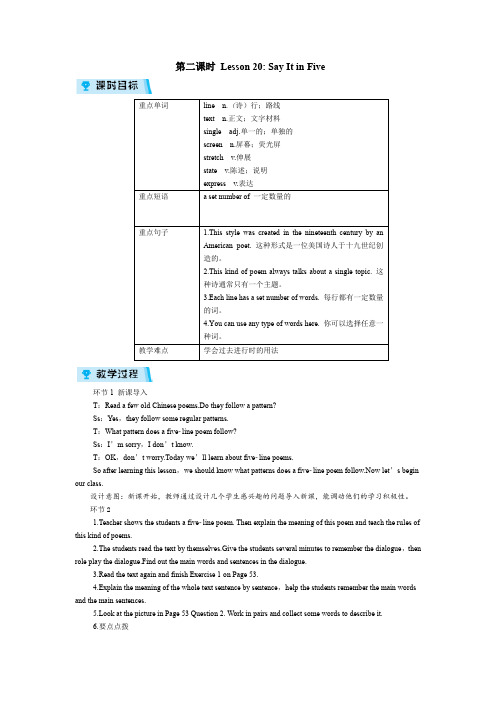
第二课时Lesson 20: Say It in Five环节1 新课导入T:Read a few old Chinese poems.Do they follow a pattern?Ss:Yes,they follow some regular patterns.T:What pattern does a fiveline poem follow?Ss:I’m sorry,I don’t know.T:OK,don’t worry.Today we’ll learn about fiveline poems.So after learning this lesson,we should know what patterns does a fiveline poem follow.Now let’s begin our class.设计意图:新课开始,教师通过设计几个学生感兴趣的问题导入新课,能调动他们的学习积极性。
环节21.Teacher shows the students a fiveline poem. Then explain the meaning of this poem and teach the rules of this kind of poems.2.The students read the text by themselves.Give the students several minutes to remember the dialogue,then role play the dialogue.Find out the main words and sentences in the dialogue.3.Read the text again and finish Exercise 1 on Page 53.4.Explain the meaning of the whole text sentence by sentence,help the students remember the main words and the main sentences.5.Look at the picture in Page 53 Question 2. Work in pairs and collect some words to describe it.6.要点点拨(1)This kind of poem always talks about a single topic.这种诗通常只有一个主题。
- 1、下载文档前请自行甄别文档内容的完整性,平台不提供额外的编辑、内容补充、找答案等附加服务。
- 2、"仅部分预览"的文档,不可在线预览部分如存在完整性等问题,可反馈申请退款(可完整预览的文档不适用该条件!)。
- 3、如文档侵犯您的权益,请联系客服反馈,我们会尽快为您处理(人工客服工作时间:9:00-18:30)。
第四课时Lesson 10: Touch the World
环节1 新课导入
多媒体展示海伦·凯勒的图片。
T:Boys and girls,look at the picture. Who is she,can you tell me?
Ss:Yes.She is Helen Keller.
T:Yes,very good.What is she famous for?
Ss:She is a wellknown writer and educator.
T:Yes,Helen Keller is deaf and blind.But how could she overcome it? Ss:...
T:OK.Let’s learn Lesson 10 to learn more about Helen Keller.
设计意图:图片导入本课话题,师生互动,激发学生的学习兴趣,创设轻松的学习氛围,开发他们的最大潜能,从而使这堂课在最大程度上达到最高效能。
环节2
1.Show some pictures of the new words on the screen.Ask Ss to try to read these words.
2.Let students read the lesson and answer the questions of Exercise 1 on Page 25.
3.Work in group of 8 to find out the key words,phrases and sentences. Then discuss them with other group members.
4.Teacher translates the whole passage and explains the sentences and grammars that students can’t understand.
5.Let students do some exercises of Exercise 2 and Exercise 3 on Page 25.
6.Check the answer.
7.要点点拨
(1)Helen Keller,the wellknown writer and educator,died yesterday at the age of 88.
海伦·凯勒,著名的作家和教育家,昨天去世了,享年88岁。
writer名词,“作家”,是动词write的名词形式。
educator名词,“教育家”,其动词为educate“教育”。
at the age of...在……岁时。
相当于when sb.+be+岁。
(2)When she was nineteen months old,Helen fell ill.当海伦十九个月大的时候,她生病了。
fall ill生病。
同类用法的还有:fall asleep入睡。
(3)She had a high fever that made her blind and deaf.她发高烧,并使她失去了视力和听力。
句子结构:本句是由that引导的定语从句。
have a fever发烧。
(4)Before her illness,Helen was a bright and happy girl.
在她生病之前,海伦是一个开朗快乐的女孩。
illness名词,“病”;是由形容词ill+ness构成的名词。
同样的词还有:kindness,goodness,business,happiness等。
(5)After she lost her ability to see and hear,she became difficult and wild.
在失去了听力和视力后,她变得难以相处,脾气暴躁。
句子结构:本句是由after引导的时间状语从句。
ability名词,“能力”。
(6)Anne was filled with pride.安妮很骄傲。
be filled with...充满了……,相当于be full of...。
(7)As Helen grew older,she made a lot of progress and learned to read.随着海伦不断成长,她取得了很大的进步并学习阅读。
句子结构:本句是由as引导的时间状语从句。
make progress取得进步。
(8)She did her best to help others in the community who were deaf or blind.她尽她最大的努力去帮助社区里其他的聋哑人或盲人。
句子结构:本句是由who引导的定语从句,先行词是others,who were deaf or blind作others的后置定语。
do one’s best to do sth.尽某人最大努力去干某事,相当于try one’s best to do sth.。
设计意图:培养学生综合阅读的能力,以及语言的实际运用能力。
请完成本课对应训练!。
